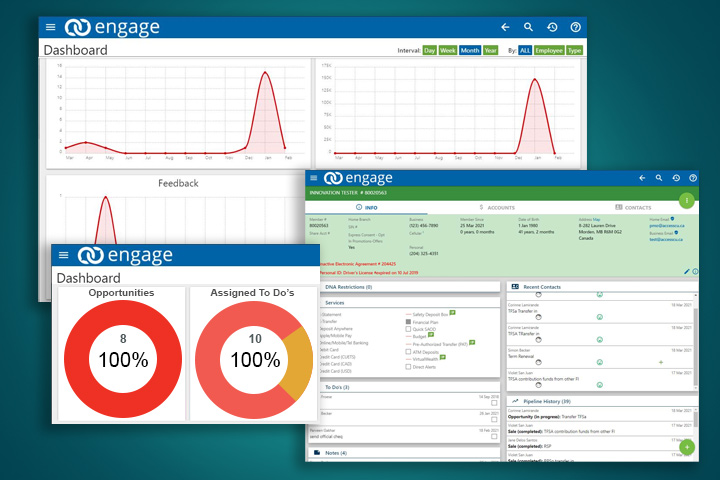Case study
Access Credit Union: Integrating a Custom-Built CRM with Celero’s integration services
Access Credit Union (Access) is Manitoba’s second largest credit union, with over $5.8 billion in assets. Access has operated in Manitoba for over a decade in its current form, but it’s history dates back to the 1930s when the credit union’s first branches were established. Today, Access serves over 90,000 members across 26 branches in urban and rural Manitoba.
Access is the type of credit union that has always pushed the limits of innovation and tends to be an early adopter of new technologies. They have an extremely strong business integration and development team that allows them to prioritize innovation and test new ideas.
In 2018, they had an ambitious idea that would completely revolutionize their employee and member experience: build a customized customer relationship management (CRM) platform that would streamline day-to-day operations of the credit union by unifying member information across applications.
This CRM (now known as Engage) would consolidate data about members into a single pane view, simplifying processes for in-branch employees interacting with members, improving speed of service delivery by resolving member interactions more quickly, and creating efficiencies by reducing the number of applications an employee would need to interact with when dealing with a member face-to-face.
Ultimately, Access’ goal was to eliminate the need for employees to interact directly with their banking system and other applications by creating Engage.
Challenge
Access had the expertise in-house to build the CRM, their challenge was they were missing a key piece of technology to make Engage truly functional.

With their current technology set up, their CRM could only act as a one-way pipeline to view member information. Having read-only access to member information in their banking system and other applications would only be so helpful to Access employees – even with a consolidated view.
Access needed to create a two-way pipeline that would allow employees to view and modify member information in real-time. Any updates made about a member needed to feed back into the banking system and any other relevant applications to generate the functionality they were looking for.
The problem was they couldn’t just link the CRM directly to their banking system and other applications. A key tenant of development principles is that you never give direct access to your system of record to end-users – doing so would pose significant security risks and would open opportunities for irreversible errors to be made to the database.
Affordable integration
Access needed an integration layer to fill the gap and act as a middleman between the CRM, their banking system and other applications. This integration layer would also need to give Access scalability for future technologies so they could easily plug new applications into the CRM using APIs.
The challenge for credit unions looking for integration platforms that offer the type of API connectivity they need is that many of them are cost prohibitive. This is because they have been designed by big market players who cater to large financial institutions and corporations in other industries who have the financial resources required.
These other players typically charge per API connection. The licensing costs for these individual connections add up quickly: for example, a credit union would have to purchase licensing for deposits, loan processing, retirement accounts – and that barely scratches the surface of all the licenses a typical credit union would need.
Access needed an integration solution that would be financially feasible for them in the long term, especially as they added more API connections.
Solution
Access knew from their role on the Banking Transformation Council (BTC) that an integration platform purpose-built for credit unions was already in development. Our integration services were the perfect solution to act as the integration layer for their CRM.

At this point, our integration services were still in their early days. Working with Access was an excellent opportunity to test how the integration services would function with a tool that was built in-house by a credit union. In fact, integrating Access’ CRM was the first time we were able to use our integration services in production with a custom-built application like Engage.
Our integration services would act as the two-way API connection hub Access needed to secure, use and consume data. The ability to connect and exchange information across systems is a crucial part of banking today, and platforms like our integration services allow financial institutions to link their data to the real-world banking experience of members.
Our integration services were built with affordability in mind to democratize access to integration platforms for credit unions.
The business model for our integration services are fundamentally different: pay one monthly subscription, get unlimited access and connect as many APIs as you want. Using this model for our integration services would allow Access to harness and move their data from across their various systems in a cost-effective way. This meant we would procure all of the APIs they needed, they would get as many testing databases as they wanted, and the price would remain the same.
This was essential for Access to meet their goals on scalability for the platform: Our integration services were built to be vendor agnostic, meaning Access could connect any future applications and integrate them into their CRM without limitations on the platform’s capabilities.
Implementation plan
Our integration services already had tested and proven capabilities, so our first step was to work with Access to connect their banking system to a test instance with the integration services.

Our team held regularly scheduled meetings with the Access team to review the APIs they needed to integrate into their CRM and our integration services. We also provided complete API documentation, showed the Access team how to use the APIs and walked them through their first use-case.
With development projects such as this, hands-on learning is everything. We set their development team up with a sandbox to test the APIs so they could build their understanding in preparation for go-live.
As their team began testing, we regularly monitored that they were securely using the APIs and only connecting to the information they were trying to access. Once we were all confident they had a solid development foundation for connecting APIs in our integration services, the Access team was able to build APIs into their applications, test them again and finally receive their production credentials to connect into their banking system and other applications for real.
After go-live, we supported Access every step of the way with incident logging and error reporting, ongoing system monitoring and providing access to research tools. One of the most significant differentiators for our integration services and credit unions is that they get ongoing access to our integration experts whenever they need help. This type of support is not something credit unions would typically receive from large integration players after go-live, and it truly sets us apart.
Results
Access went live with our integration services in November of 2019. Ultimately, the integration services gave Access the freedom and flexibility to control their own destiny and move as quickly as they wanted with innovation.

With the successful introduction of the Engage CRM that was integrated with our integrated services, Access was able to give their employees a modernized user interface and 360-degree view of members all within Engage.
They achieved their goal of helping employees avoid having to go into the banking system to find information and consolidated all member information (including credit card information, RESP information and more) into a single CRM dashboard that was fully editable. This streamlined routine tasks for employees, creating a better, more efficient member experience and increased productivity for employees.
Access was also able to experiment with new features and functionalities using our integrated services and their CRM, including a new “nicknames” feature that would allow in-branch employees to know how a member prefers to be addressed in their interactions with the credit union, leading to a more positive member experience.
Success achieved
- Increased reliability and availability: Access has used our integration services’ API’s for 18 months now and find them to be reliable and available.
- Increased productivity and faster processing of member requests: On average, Access is now processing about 50 interactions per day with our integration services. This has led to increases in productivity among member-facing employees as they are able to complete tasks more quickly by eliminating the need to work across multiple applications.
- Successful implementation in under two months with minimal human resource expenditures: The support Access has received (either directly with our integration services team or the API documentation) has served as the cornerstone for their successful production implementation. Access was able to develop, test, and get into production implementation within two months of starting the integration services project using a single developer who was assigned to the project.
- Minimal disruption for front line employees with each update: Our integration services have grown incrementally since day one. Access has taken the approach of building momentum which started with quick wins and built on those successes over time. This has helped minimize disruption to Access employees who are using the tool.
- Fostering a member-first approach to development and continuous improvement: Access has maintained a highly collaborative approach to development with our integration services by seeking staff feedback that has allowed the development team to prioritizing certain features, focusing on the most important capabilities first to create the most value for members.
- Streamlining of data entry processes and introduction of new features: Since the initial implementation of the “nickname” update API, Access has added support for a member contact information update API. Attributes such as member name, date of birth, phone number, email address, and person user field values are now updated using the API from within Engage that is facilitated by the two-way information pipeline managed through our integration services.
Access Credit Union today
Access continues to build out their capabilities and API integrations with Celero’s integration services. We remain a solid partner for Access, lending our expertise on how to introduce new features and functionalities to their CRM using our integration services.
We’re proud to see the success Access has achieve with our platform and look forward to seeing where their innovation journey will lead them next.